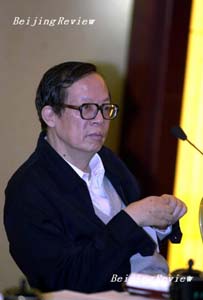
Anyone who reads a book or newspaper in Chinese is indebted to Wang Xuan, a pioneer in modern Chinese-language printing, just as one can thank Thomas Edison for inventing the electric light bulb.
Wang invented a computerized laser photocomposition system for Chinese character typesetting, helping China independently make the leap from letterpress printing to electronic publishing.
Wang died of an illness on February 13 in Beijing at the age of 69. Senior Chinese leaders, including President Hu Jintao and Premier Wen Jiabao, joined people from all walks of life in paying their respect at his funeral.
Wang was born in February 1937 in the city of Wuxi, in east China’s Jiangsu Province. He was vice chairman of the 10th National Committee of the Chinese People’s Political Consultative Conference (CPPCC) and a professor at the elite Peking University. Also an academician at both the Chinese Academy of Sciences and the Chinese Academy of Engineering, he was proficient in computer applications for processing words and photos.
“We knew each other for 20 years,” said Ni Guangnan, an academician with the Chinese Academy of Engineering. “Wang struck me as a person full of innovation. He was both a prominent scientist and a dedicated entrepreneur. His typesetting system is a paradigm of innovation.”
Wang’s work has been described as the “second invention of the printing system for Chinese characters” after Bi Sheng’s development of movable clay type in the Northern Song Dynasty (960-1127), which ushered in a printing revolution.
Using laser technology
In 1975, when Chinese printing companies were still setting type by hand, Wang led the development of an integrated microchip circuit to efficiently store compressed information in Chinese characters.
With the anticipation of the future application of laser technology, Wang invented an advanced laser typesetting system and produced a laser typesetting machine for Chinese characters.
“His invention has ushered Chinese printing into a new era of computers and lasers, out of the age of fire and lead,” former Vice Premier Fang Yi commented in 1980.
Wang patented the system in Europe in 1982.
In early 1985, Wang’s system was put into service at the official Xinhua News Agency. According to Kang Baoshan, head of the typesetting division of Xinhua’s subsidiary printing factory, before the system was installed, workers set the type by hand, which was very timeconsuming.
At that time, the factory only printed three newspapers and several magazines. The more than 100 workers in the typesetting division could only set 1 million words a day, but nowadays the factory is able to print more than 30 newspapers. It can complete one newspaper page in about 20 minutes, compared to the several hours the process used to take.
People’s Daily, China’s largest newspaper, began using Wang’s system in 1990. Zhang Suhua, a printing division employee, said Wang’s invention was significant because it had “helped liberate Chinese printing workers from strenuous physical work.”
Zhang said she used to run between
| .jpg)
.jpg)